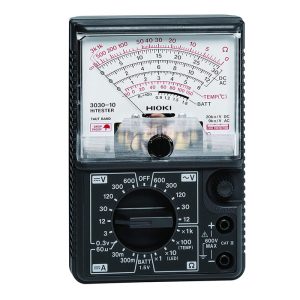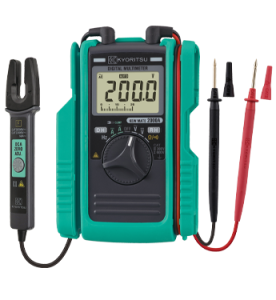Do you need a top-notch multimeter to check different electrical parameters? Do you wish to learn how to select the best multimeter for your requirements and price range?
You are in the appropriate location if so. Four multimeters from Kyoritsu and Hioki that are available on the website mme-ae.com will be compared in this article.
We’ll examine their features, attributes, costs, and warranties to help you choose the one that’s ideal for you.
Table of Contents
ToggleFor instance:
As you can see, every multimeter offers a unique set of benefits. You can select the option that best suits you based on your needs and preferences.
Here are some recommendations to aid with your decision-making:
Think about the metrics you want to track and how frequently.
Examine the attributes and details of each multimeter.
Each multimeter’s cost and warranty should be compared.
Before making a decision, study additional customer reviews and ratings at mme-ae.com.
We trust that this post has aided you in your search for the ideal multimeter.
Feel free to email us or post a comment below if you have any questions or concerns. Happy measuring, and thanks for reading.
We shall contrast four multimeters from Kyoritsu and Hioki that you may discover on the website mme-ae.com to help you respond to this topic.
Which are:
The MODEL 1110 of the Kyoritsu Analogue Multimeters
AHIKI HiTESTER 3030-10
KEW 1109S Kyoritsu
KEWMATE 2000A from Kyoritsu
We’ll examine their features, attributes, costs, and warranties to help you choose the one that’s ideal for you.
Features:
The capabilities and features of a multimeter are its features. They establish what can be measured and how it can be measured. Typical characteristics of a multimeter include:
The display, which can be either a dial or a screen, shows the measurement value. It could be analogue or digital. Analogue displays represent the value with a pointer on a scale, while digital displays show the value as digits.
Generally speaking, a digital display is more accurate and easier to read than an analogue one. Additionally, some digital displays have a backlight feature that allows for visibility in low light.
Range:
The range of values that a multimeter is capable of measuring for each parameter. For instance, a multimeter with a range of 600V may measure voltage up to that amount.
A multimeter with a voltage range of 0.1V to 1000V can measure voltage in that range. A multimeter may measure more values for each parameter if its range is larger.
Accuracy: This refers to how closely a multimeter’s measurement value matches the actual value of the parameter being measured.
A multimeter is accurate if, for instance, it reads 100V while measuring a voltage source with a genuine value of 100V. It is incorrect if it reads 101V or 99V.
The proportion of inaccuracy or variation from the true number is typically used to express accuracy. A multimeter is more accurate for each parameter when the percentage is smaller.
The test leads or probes used to connect the multimeter to the circuit or object being measured are plugged into the input terminals, which are the sockets or holes. For various parameters and ranges, several input terminals are utilised.
For instance, whereas certain input terminals are used to measure current or capacitance, others are used to measure voltage and resistance. Additionally, some input terminals have safeguards that guard against electric shocks and short circuits.
Test leads are the wires or cables used to link the multimeter’s input terminals to the circuit or object being measured.
They often have metal tips or clips on both ends that connect to the measuring locations and the input terminals. Test leads should have the correct ratings for the parameters and ranges being tested and be compatible with the input terminals.
Functions:
These are the switches or buttons that let you choose or modify the multimeter’s parameters, ranges, modes, or settings.
For instance, you can switch between manual and automatic range selection, between normal and relative mode, and between AC and DC voltage or current with various functions.
These are some extra features that some multimeters have in order to improve their functionality or usability.
For instance, some extra features are:
Data hold function: This lets you freeze the value shown on the screen for later use.
You can record the peak value of inrush currents or voltage spikes using the peak hold function.
Utilise the auto zero function to get rid of the offset value brought on by lingering magnetism.
Auto power down feature:
By shutting the multimeter off after a certain amount of inactivity, this function extends battery life.
When the battery is getting low and needs to be replaced, the low battery indicator will let you know.
In order to observe or record the measurement value, you can connect the multimeter’s output terminal to an external device such an oscilloscope or a recorder.
Use the transistor tester feature to gauge a transistor’s gain and leakage current.
Battery check function: With this, you may check the voltage of dry batteries while they’re being used.
Overload protection circuit:
This guards against harm from excessive input to the multimeter.
Clamp sensor: By clamping around a conductor, this sensor enables you to monitor currents without disrupting the circuit.
Let’s compare the four multimeters from Kyoritsu and Hioki now that we have seen some of the common features of a multimeter:
The Kyoritsu Analogue Multimeters MODEL 1110 contains a continuity buzzer, an output terminal, input terminals and test leads with safety designs, and an analogue display with a mirrored scale.
It is capable of measuring continuity, resistance up to 2k, DC current up to 300mA, and AC and DC voltage up to 600V. It doesn’t come with any extra features.
A digital display with a backlight function, a data hold function, a low battery indicator, and an auto power off function are features of the HIOKI HiTESTER 3030-10.
It can detect continuity, resistance up to 60M, capacitance up to 100F, frequency up to 1MHz, temperature up to 300°C, and AC and DC voltage up to 600V. It doesn’t come with any extra features.
The Kyoritsu KEW 1109S contains an overload protection circuit, a transistor tester function, a battery check function, and an analogue display with a high sensitivity of 20k/V.
It is capable of measuring continuity, AC and DC voltage up to 1000V, AC and DC current up to 10A, resistance up to 20M, and decibels between -10dB and +62dB. It doesn’t come with any extra features.
Digital display with bargraph display, data hold, peak hold, auto zero, and auto power down functions are all features of the Kyoritsu KEWMATE 2000A.
Additionally, it has an open clamp sensor that is capable of measuring both AC and DC currents up to 60A without tripping the circuit.
It can measure continuity, resistance up to 34k, frequency up to 1kHz, and AC and DC voltage up to 600V. It doesn’t come with any extra features.
As you can see, every multimeter has unique features that make it appropriate for a variety of uses and circumstances.
The one with the qualities you want and need should be your choice. For instance, you should pick the HIOKI HiTESTER 3030-10 if you require a multimeter that can detect capacitance and temperature.
The Kyoritsu KEW 1109S is the multimeter to use if you need to measure transistors and decibels. The Kyoritsu KEWMATE 2000A is the best option if you require a multimeter that can measure currents without interrupting the circuit.
The Kyoritsu Analogue Multimeters MODEL 1110 is the best option if you require a straightforward and reliable multimeter.
Specifications
The numerical values that characterise the performance and quality of a multimeter are known as its specifications. For each parameter and range, they determine the multimeter’s accuracy and precision. A multimeter’s common specifications include some of the following:
Range:
The range of values that a multimeter is capable of measuring for each parameter. For instance, a multimeter with a range of 600V may measure voltage up to that amount. A multimeter may measure more values for each parameter if its range is larger.
As you can see, every multimeter has unique features that affect how accurate and precise it is for every parameter and range. You ought to pick the option whose characteristics match your needs and expectations.
Select the multimeter with the highest resolution for those parameters, for instance, if you need one that can detect very minute changes in voltage or current.
The multimeter with the broadest range for those parameters should be used if you require one that can measure extremely high or low amounts of voltage or current.
Select the multimeter with the highest accuracy for those parameters if you require one that can measure with the least amount of error or departure from the true value.
Choose the multimeter with the highest overload protection for those parameters if you require one that can withstand high inputs without being damaged.
Costs and Guarantees
The monetary values that represent a multimeter’s cost and quality are its prices and warranties. They decide how much you must pay and how long the multimeter can be used without incident. A multimeter’s typical costs and warranties include things like:
Price:
The cost of the multimeter is the sum of money you must pay. Typically, it depends on the multimeter’s features, specifications, brand, and quality.
A multimeter with a greater price typically comes with more features, better specifications, a more reliable brand, and higher quality.
A higher price does not, however, always imply better quality or happiness. You should evaluate the value of several multimeters by comparing their pricing.
Warranty:
This is the time frame during which the vendor or manufacturer promises that the multimeter will function properly and without flaws.
In most cases, it includes the cost of repairing or replacing the multimeter if it malfunctions or is damaged as a result of a manufacture flaw or ordinary use. A multimeter with a longer warranty is typically of greater calibre and dependability.
A lengthier warranty, however, may not necessarily cover all issues or circumstances. You should carefully examine the warranty’s terms and conditions to determine what it covers and what it doesn’t.
Now that we have seen some of the typical multimeter pricing and warranties, let’s compare the prices and warranties of the four multimeters from Kyoritsu and Hioki:
The Kyoritsu Analogue Multimeters MODEL 1110 has a one-year warranty and costs AED 250.00.
The HIOKI HiTESTER 3030-10 has a three year warranty and costs AED 450.00.
The Kyoritsu KEW 1109S has a one-year warranty and costs AED 350.00.
Priced at AED 400, the Kyoritsu KEWMATE 2000A comes with a 12-month warranty.
As you can see, the pricing and warranties for each multimeter vary based on how much they cost and how well they are made.
Choose the product that is within your price range and has a suitable warranty.
For instance, the Kyoritsu Analogue Multimeters MODEL 1110 is a good option if you want to buy an inexpensive multimeter.
You should also take into account the fact that it differs from the other multimeters in that it has less features, poorer specifications, and a shorter warranty.
The HIOKI HiTESTER 3030-10 is the multimeter to get if you want to spend money on one.
You should also take into account the fact that it is superior than other multimeters in terms of features, specifications, and warranty length.
The four multimeters from Kyoritsu and Hioki have now been compared. We hope that this comparison has aided in your search for the ideal multimeter.
On the website me-ae.com, you can acquire these multimeters online or get more information about them by getting in touch with customer support.
In conclusion, we evaluated four multimeters available on the website mme-ae.com from Kyoritsu and Hioki. We helped you choose the best option for you by examining their features, characteristics, costs, and warranties.
You can select the option that best suits you based on your needs and preferences. Here are some recommendations to aid with your decision-making:
Think about the metrics you want to track and how frequently.
Examine the attributes and details of each multimeter.
Each multimeter’s cost and warranty should be compared.
Before making a decision, study additional customer reviews and ratings at mme-ae.com.
We hope that this comparison has aided in your search for the ideal multimeter.
Feel free to email us or post a comment below if you have any questions or concerns. Happy measuring, and thanks for reading!




